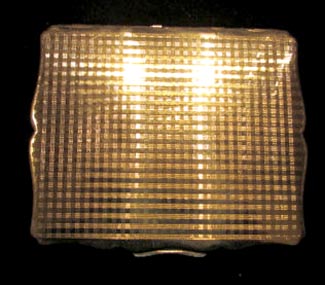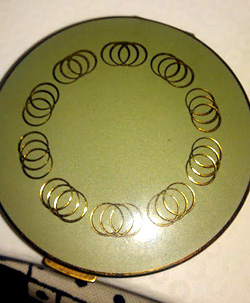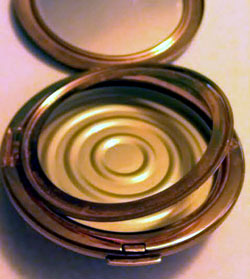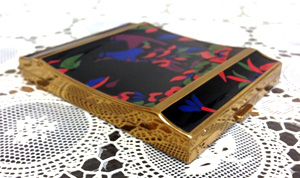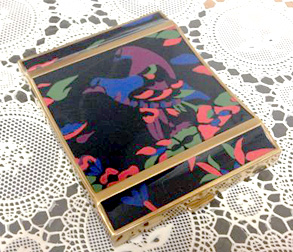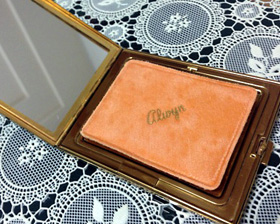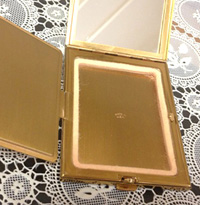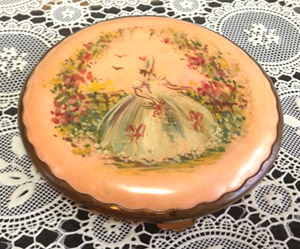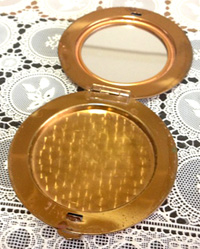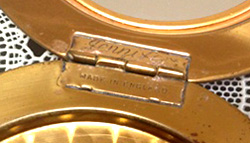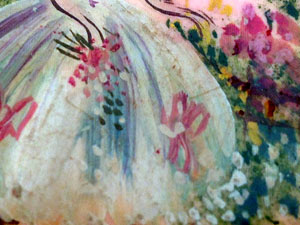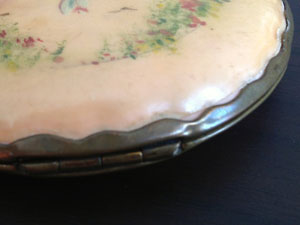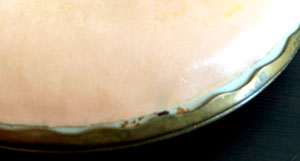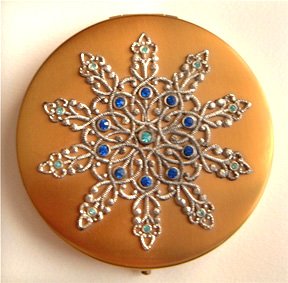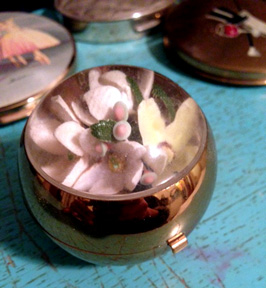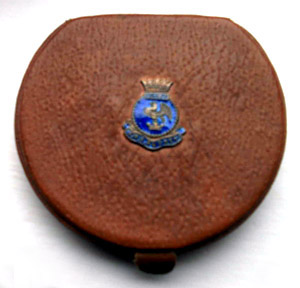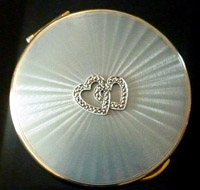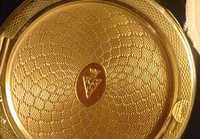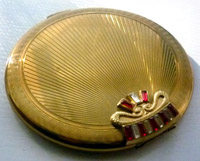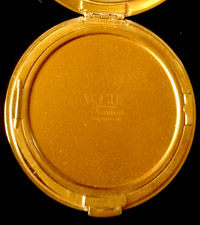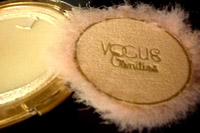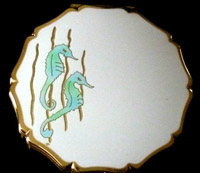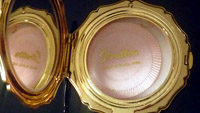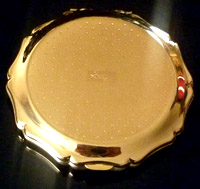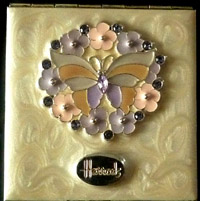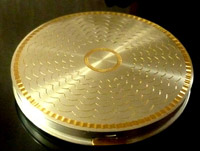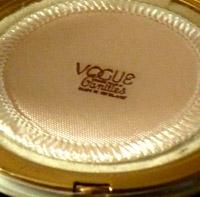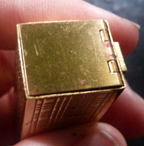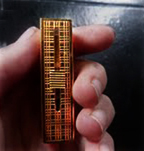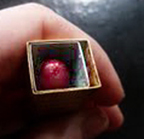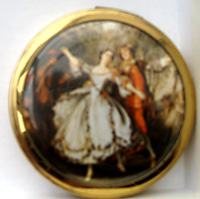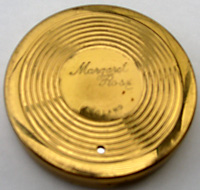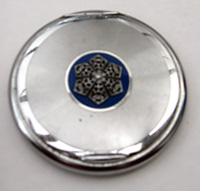Hi
everyone,
I am a new member and have been left
approximately 50 compacts of various sizes
shapes and makes by my late step gran.
I don't know much about them. I have a few that
seem to be very interesting and in the process
of photographing them.
One in particular of interest is a small round
silver metal compact approx 2" with made in
Britain and with a label that says Rachel on the
bottom of the compact. The lid has a Edward 8th
coin in it, surrounded by scalloped blue enamel
? hard to tell as this is covered by celluloid
or bakelite. Was it made to commemorate his
coronation. I also have a compact by
Belmar which is square silver plate and gilt
interior it has possible Masonic or religious
symbols on the case. I can find no information
on Belmar.
I hope you can help without photos, will send
some when i get them all done
Best Wishes and thank you for your help.
Beverly Eastham a new and confused member.
Jenny
Duncan replies:
Welcome
to the BCCS and to the fascination of
compact collecting. Many
of us, including myself, have begun
compact collecting because of treasured
compacts left to us by someone in the
family.
Please don’t be confused,
just take your time and enjoy them! So
much of the fun of compact collecting is
what we can find out about our compacts.
Our founder Juliette has always encouraged
us to share what we know, so that we can
better appreciate these lovely
collectables and along the way we will
make new friends. Thank
you for your interesting question and it
is due to our wonderful Convention in 2012
that I can begin to respond at least to
part of it.
On
display in our “Best of British”
exhibition and shown on page 25 of the
exhibition catalogue (which is still
available to buy) is a compact in silver
metal with a bronze coloured metal image
of Edward VIII with the words CORONATION
OF KING EDWARD VIII 1937. The
coin is like a pre-decimal penny coin,
framed in silver-tone metal, so differs
from your own compact with its blue
surround.
The bronze image of Edward shown on
the compact in the exhibition catalogue
faces to the right and shows the collar of
a military uniform.
While
it resembles a coin, Mary Baker, the
Convention organizer and author of the
catalogue, notes that on coinage to be
minted, Edward had insisted that he should
face left to show the parting in his hair. This
was a departure from the tradition that
each successive monarch faced in the
opposite direction to his or her
predecessor. Since Edward’s
father, George V, had faced left Edward
himself should have faced to the right.
Only a
very small number of proof coins were
struck before the abdication. These are
amazingly rare and show a profile of
Edward’s head and neck facing left with no
representation of a collar on a military
uniform.
They were never in circulation as
he abdicated in December 1936. This
means that the coin in the exhibition
compact would never have been a coin of
the realm from the Royal Mint, but was
made as a commemorative, in the
expectation that he was be represented in
the traditional way.
Please
check your compact to see if Edward is
facing to the right and wearing military
uniform, as this means that it was not a
coin of the realm. However, it is most
likely that your compact would have been
made in 1936 to commemorate Edward’s
anticipated coronation in 1937, which of
course never took place.
It is
unlikely that your compact has an enamel
surround, since you mention that it is
covered with a type of celluloid or
another early plastic. Enamel would not
need this type of protection. There were,
however, ways of making a decorative
finish that resembled guilloche enamel. These
sometimes used foil under celluloid or,
alternatively, metal coatings were applied
to one side of a celluloid sheet, which
was then impressed with a pattern so that
it looked like enamel.
The
compact depicted in the exhibition catalogue
was designed to take a small pan of
compressed powder, known as a godet. It
is inscribed on the base RACHEL – MADE IN
ENGLAND and is 50 mm dia. You describe your
compact as having a label on the base which
says RACHEL.
“Rachel” was very often used as a
name of the colour of pressed powder. At
the present time we do not know which
British company made these commemorative
compacts with their imitation coins.
Your
compact marked “Belmar” is a mystery to me
and when you are able to photograph it,
please send us some pictures. I
do not know this name as a compact brand
and at present can shed no light on it. I’m
assuming from your description that the
word “Belmar” is impressed in small
letters into the metal case, in a way that
would suggest a maker’s name?
Compacts
may be found with masonic insignia,
usually the set-square and compasses or a
special badge for a particular masonic
lodge.
You would be able to find this out
yourself through internet searching. These
would have been presented as gifts on
Masonic Ladies’ Nights, when wives of
Masons were invited for a special dinner.
It’s
always fascinating to come across
something unusual and if I can find out
about Belmar then I’ll be in touch again.
|
